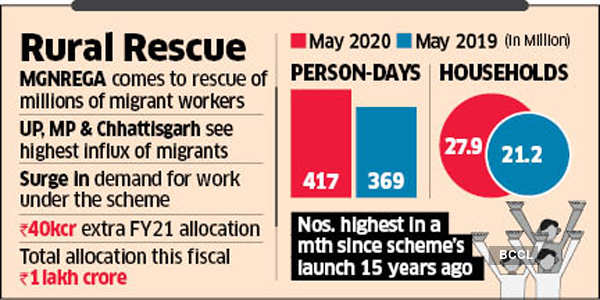
New Delhi: The Mahatma Gandhi National Rural Employment Guarantee Scheme (MGNREGS) has set new records on the number of person-days of work generated and households benefited under it in May, a month that saw largescale reverse migration from cities.
As many as 417.7 million person-days of work, a 13% rise from a year earlier, was generated last month, according to government data. The number of households covered under the scheme shot up 31% on-year in the past month to 28 million. These are the highest ever for a month since the launch of the scheme 15 years ago.
Uttar Pradesh, Chhattisgarh and Madhya Pradesh saw highest jump in job demand. These states have also seen a large influx of returning migrant workers.
While UP saw 50.5 million person-days of work under the scheme in May compared with 17.4 million person-days the same month last year, the number rose to 41.5 million from 24.3 million in Chhattisgarh and to 37.3 million from 24.6 million in MP.

Impact on Wages
Experts said if the trend continued for long, it would cause an acceleration in inflation by pushing up wages in urban areas.
“Excessive supply of labour in rural areas will keep rural wages depressed while their shortage in urban areas will result in an increase in wage cost of these workers in cities,” India Ratings chief economist DK Pant said.
According to Pant, a higher wage cost, in turn, would exert pressure on the balance sheet of companies and thus impact investments in the long run.
Pointing out the challenge before the government to sustain the employment guarantee scheme in the long run with the current demand, Jawaharlal Nehru University economics professor and rural expert Himanshu said the programme had the potential to absorb as many people and create assets in rural India but the cost of doing it would be huge.
“The Centre will have to bear the burden of the increase in cost if these workers remain (in rural areas) for long and demand 100 days of work as provided under the scheme,” said Himanshu, who uses only one name.
The government has enhanced the allocation for the scheme by ₹40,000 crore from the Rs 61,500 crore sanctioned in Budget 2020-21, taking the total to more than Rs 1 lakh crore — the highest since its rollout in 2005.
It is estimated that more than 58,00,000 migrants have travelled to their native towns and villages since May 1 using the Shramik special trains. There would be several thousands more who would have travelled by buses and other means till the railways launched the dedicated services for migrant workers.
The 2011 Census had pegged the number of migrants at 30 million. It is estimated that by 2020, this would have increased to 40 million.
Source: indiatimes.com

